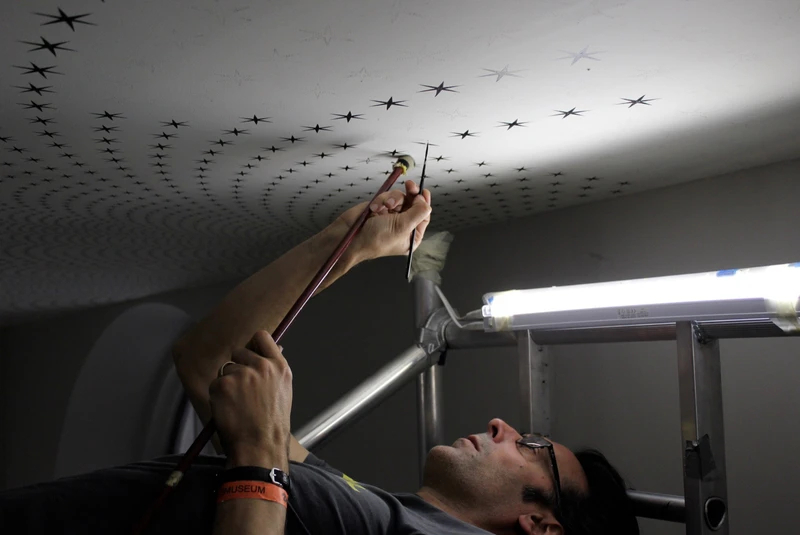Richard Wright


b. 1960, United Kingdom
British painter and muralist, born 1960
Painting is an act that connects reality and consciousness. It is more than a collective codification of signs. It is a performance that awakens the delirium of vision.
—Richard Wright
Richard Wright is known for large-scale and site-specific—but often temporary—painted and applied metal-leaf installations and leaded window works that invest architectural spaces with new optical and associative complexity. Shifting between illusionism and abstraction, his projects alter the viewer’s perception of space. Incorporating graphic and ornamental elements, his work often alludes to Minimalism and Renaissance art as well as to commercial images. In his stylistically diverse works on paper, Wright employs ink drawing, gilding, printmaking, enamel, and watercolor painting techniques that Camden Art Centre director Martin Clark described as having an “allover quality that seemed to exceed the limits of the paper, a field of indeterminate shapes and matter: drifting, coalescing, accreting and dissipating, like the curl of vapour in an alchemist’s alembic.”
Wright was born in 1960 in London and moved to Scotland with his family when he was young; he now lives and works in Norfolk, England, and Glasgow, Scotland. He graduated with a BA from Edinburgh College of Art in 1982 and an MA from Glasgow School of Art in 1995. Initially producing figurative painting, he became disillusioned with the methodology in the late 1980s and abandoned his art practice altogether for two years to train as a professional sign painter. While studying in Glasgow he destroyed all his work on canvas and began painting directly onto the walls of exhibition spaces, often focusing on corners and other marginal areas to emphasize the interaction of his imagery with its built environment.
Wright’s earliest site-responsive works are characterized by geometric shapes, but the artist soon began to also adopt motifs inspired by Gothic iconography and other visual disciplines such as tattoo illustration. The first solo exhibition of his work took place in 1994 at Transmission Gallery in Glasgow, and he quickly came to be considered—alongside Martin Boyce, Douglas Gordon, Simon Starling, and Cathy Wilkes—one of the key artists to have emerged from the city over the course of that decade. Since then, Wright’s work has been shown in major exhibitions worldwide, including Kunsthalle Bern (2001); Tate Liverpool, England (2001); Dundee Contemporary Arts, Scotland (2004); No Manifesto, Galleria d’Arte Moderna e Contemporanea di Bergamo, Italy (2005); Carnegie International, Pittsburgh (2008); Scottish National Gallery of Modern Art, Edinburgh (2010); Theseus Temple, Kunsthistorisches Museum Wien, Vienna (2013); and Walk through British Art, Tate Britain, London (2013). In 2009, Wright was awarded the Turner Prize.
In addition to permanent private commissions, Wright’s public institutional commissions include the Museum of Contemporary Art San Diego (2007); Middlesbrough Institute of Modern Art, England (2007); Dean Gallery, Scottish National Gallery of Modern Art, Edinburgh (2010); The Millbank Project at Tate Britain, London (2011–13); Rijksmuseum, Amsterdam (2013); and Drawing Biennial, Oslo (2014). In 2016, he was commissioned to make a vast permanent gold-leaf work for the 400th anniversary of the Inigo Jones–designed Queen’s House (now part of the Royal Museums Greenwich), which was the first classical building in the United Kingdom. Wright’s work cloaks the whole ceiling and upper walls of its Great Hall. In 2018 he was commissioned by the Crossrail Art Programme to make a ceiling work more than eighty feet long at the Tottenham Court Road station for London’s new Elizabeth Line, which opened in 2022.